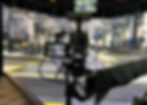Demystifying Virtual Production: ICVFX vs XR
- Marketing Target3D
- Aug 30, 2022
- 3 min read
Updated: May 24, 2023
Virtual Production is an umbrella term covering various technical pillars which means there isn’t such a thing as a ‘catch all VP studio’. At Target3D it’s important for us to understand from our clients if they want to use extended reality and virtual production or if an in-camera virtual effects route will suit them best.
Often when people hear of Virtual Production, it’s The Mandalorian that comes to mind. The thing that got everyone very excited around the production of Mandalorian was their use of LED walls - everything you saw was in-camera and utilising the parallax effect to create depth. This was primarily in-camera virtual effects (ICVFX) and not within the terminology of extended reality (XR).
So, what are the differences - and similarities - between XR and ICVFX?
Extended reality (XR) is another umbrella term that comprises AR, MR & VR and has been around longer than in-camera visual effects (ICVFX). Typically a Disguise workflow, XR is almost opposite to a green screen in that anything that isn’t on the LED screen is an extended virtual space.
One of the main differences between the two is the design of the LED walls. With XR, a right angle corner or a hexagon is created with the walls - a controlled shape that enables you to know where every single pixel is, to avoid pieces or body parts being replaced by set extension. The process of ICVFX can be more forgiving, allowing the use of a flat or curved wall, because the LED wall isn’t your hero shot, it’s a backdrop. What creates the illusion of reality is having the focus in the foreground and midground which tricks the brain into assuming what is in the background is photo realistic. This is similar to the human eye which can focus on one thing and generate a peripheral vision - the eye doesn’t really see it but your brain interprets it as real. It’s the same with ICVFX - the focus is in the foreground and because this bit is true you assume the rest of it to be true.
In a nutshell, for XR you need walls and a floor while for ICVFX you need walls and a ceiling.

Target3D provides both XR and ICVFX service work solutions and studio installs. Typically XR is more of a broadcast based system (news studios using a virtual set for sports, for example), with ICVFX used more by film and episodic TV production houses.
Depending on what a client wants to produce, as well as their timescales and budget, we explore which workflow will suit them best. Understanding the challenges and benefits is integral to this.
With XR, colour shift and being able to colour balance between the different LED walls can be a real challenge and need a lot of testing. What we see as a pixel is called a 3-in-1 SMD pixel: it has three sub pixels which are red, blue and green and when you change the viewing angle you may not be able to see one of those colours which will affect the colour balance. Disguise emphasises the use of the XR and augmented reality (AR) side of things using their workflow meaning you can add computer generated images to the set - this could be adding a CG car into the mix that the actors can’t see in the set space as an example. With XR, extended reality is your set whereas in ICVFX, the LED walls are the set, creating the parallax effect which creates a perception of depth.
ICVFX is more forgiving when it comes to the content. If it’s not perfectly aligned, people aren’t going to go missing, or have their ankles chopped off! Whereas, with XR, just two pixels out is enough to do this.

The real strength of ICVFX is that you can have a Golden Hour for twelve hours - meaning that if you are filming with a sunset you can easily adjust and control the lighting to have the sunset uninterrupted for hours while you capture the action.
One of the strengths of Target3D, in terms of virtual production, is our ability to do the entire video pipeline. We control everything from managing the source, through to processing, through to the display. We have the expertise to capture mocap and film, create the Unreal scenes, distribute that signal, do processing, data-distribution, display - the full pipeline from source to display.
Some virtual production studios will take the signal from a source and do the processing, others are a Disguise house, but Target3D works from multiple sources and multiple workflows.
Why trust Target3D for Virtual Production?
In a complex and confusing marketplace, Target3D offers full virtual production service work from consultancy to a turnkey solution. Working with all the leading VP suppliers, we are unbiased and recommend what's right for you, not what's right for us. Speak to the experts today.

%20(1).png)